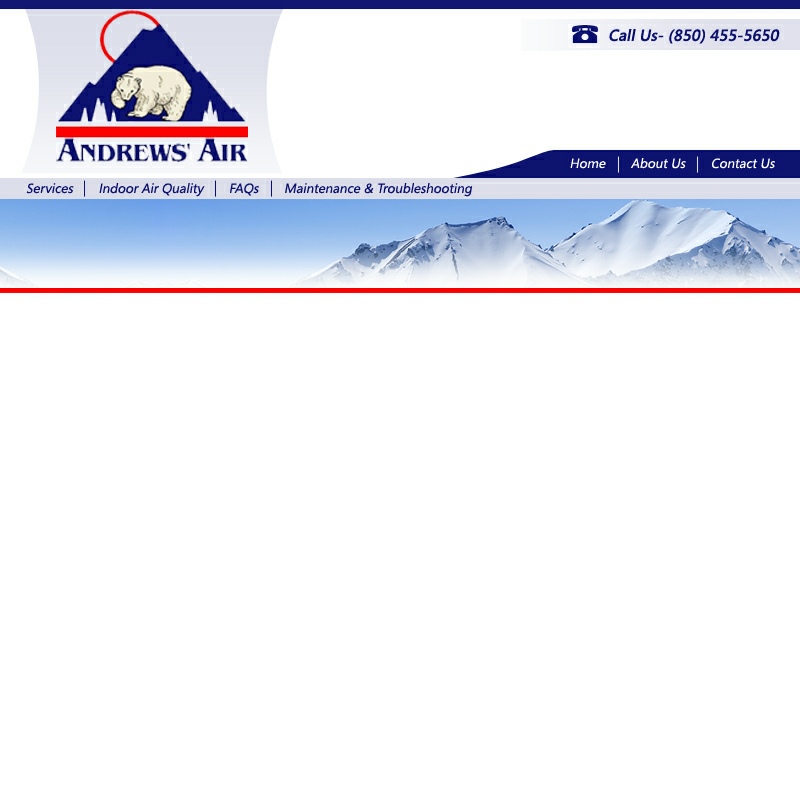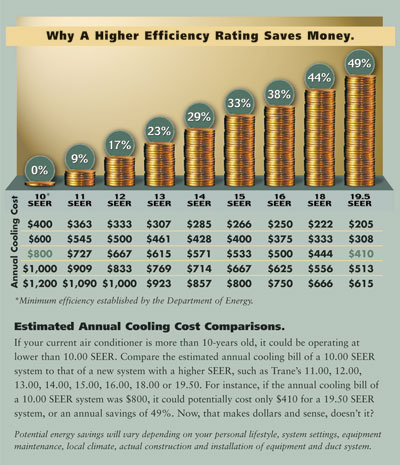

How does a central air conditioner work?
A central air conditioner helps keep your home cool and reduces humidity levels by transferring heat from the inside of a building to the outside. The compressor inside an air conditioning unit pumps refrigerant (freon) through a closed system of piping to an outside coil to gather heat and moisture from indoors. A fan blows outside air over the hot coil, transferring heat from the refrigerant to the outdoor air. Because the heat is removed from the indoor air, the indoor area is cooled.
How does a heat pump work?
A heat pump is like the air conditioner described above except it also provides heat in the winter. In the warmer months, the heat pump collects heat from the house and expels it outside. In the cooler months, the heat pump extracts heat from outside air and circulates it inside the house. The heat pump operates best when the outdoor temperature is above 32º Fahrenheit. Below that, emergency heat may be needed. A heat pump takes 30 to 60 percent less energy to supply the same heat when compared to an electric furnace with a resistance heating element.
How does a gas furnace work?
A gas furnace keeps your home warm in the winter and is an important part of your air conditioning system in the summer. In a furnace, gas is combusted in a burner. The heat produced from that reaction passes through a heat exchanger where it is transferred to the air distribution system. The duct system carries and disperses the conditioned air and the flue or vent pipe releases the byproducts, such as carbon dioxide and water vapor, outside the home.
What is a SEER?
Air conditioning equipment is rated by the Seasonal Energy Efficiency Rating, or SEER. The higher the SEER, the less energy you will use to cool your home which results in lower electric bills. Often the electric savings are enough to offset the cost of the new equipment within a few years.
Are there any rules or laws regarding SEER ratings?
Yes. To increase the energy efficiency of residential air conditioners, the Department of Energy has issued new standards that went into effect January 23, 2006. Air conditioners manufactured after January 23 must meet a higher minimum standard, achieving a Seasonal Energy Efficiency Ratio of 13 or higher. The standards, however, do not require you to change your existing heating and cooling unit, nor does it mean that replacement parts and services will no longer be available. Equipment with a rating less than 13 SEER manufactured before this date may still be sold and installed (until manufacturer's stock is depleted).
What is the average life of an air conditioning system?
It can vary, the average life of a unit is 15 years, but individual units may vary and last much longer, depending on the amount of usage and how well it is maintained. According to an ARI survey, heat pumps have about the same life span when recommended maintenance procedures were followed. Newer units are expected to last even longer.
How do I know when it's time to replace my system?
When your system is old or in need of frequent, major or costly repairs, you may want to consider replacing it. While replacing a compressor is less expensive than replacing the entire unit, a new unit may give you greater efficiency and lower your utility bill in the long run. Today's systems can be up to 60% more efficient than systems manufactured just 10 years ago.
Should I replace the indoor and the outdoor units at the same time? What if I only want to replace one or the other?
Air conditioning and heating units are designed to operate as a matched system. The
efficiency rating is based on the entire system and if you install a new, higher
SEER (seasonal energy efficiency ratio) condensing unit with an older indoor unit
you will not achieve efficiency. By replacing the entire system, your system will
be more efficient and reliable. Another consideration to be made is the refrigerant
in your current system. R-
How do I know what size unit our house needs?
Many factors are considered before recommending
what size unit to install in your home, factors like the size of the home; the type
of home -
How often should I change the air filter in my system?
Typically, filters should be replaced or cleaned at least once per month so as not to restrict the air flow through it. Some filters, such as media filters or electronic air cleaners, are washable; others are disposable and must be replaced.
What effect does sunlight have on my cooling system?
In summer, direct sunlight increases the load on your cooling system. Use of window shades and awnings will reduce the amount of direct sunlight and lower the cooling load. In winter, direct sunlight reduces the load on your heating system. Open window shades and awnings to increase direct sunlight and lower the heating load.
Can shrubs or flowers be planted around an outdoor unit?
Yes. However, we recommend that plants be at least 18 inches away from the unit. This allows for plenty of room for air circulation in and out of the unit. Without this room for air circulation, the unit could overheat, resulting in a premature need for service.
Basic rules to follow for keeping cool at minimum cost:
- Caulk, weather strip, and insulate (especially the attic) to close air gaps.
- Plan hot work (washing and drying clothes, baking, cooking) for cooler morning and evening hours.
- Pull drapes and shades over windows facing the sun.
- Keep windows and doors closed when the air conditioning is on.
- Use a thermostat control to automatically increase or decrease home temperatures for daytime and nighttime differences to save money.
- Set thermostat control at highest comfortable level, Each degree raised reduces energy
consumption by 3-
4 percent. - Clean or replace air filters regularly.
- Keep the outside unit free of leaves or other airflow obstructions.
- Have the air conditioning unit cleaned each spring.
FAQs
